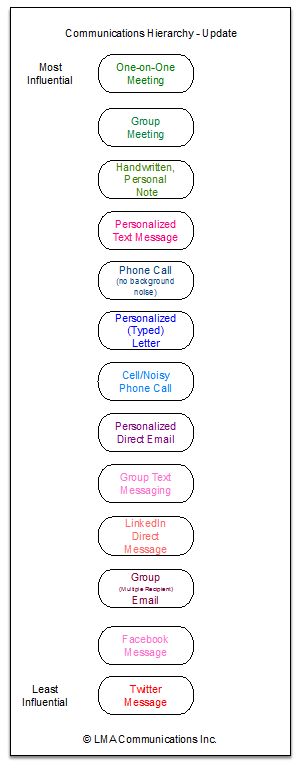
By Larry Mogelonsky, MBA, P. Eng. (www.hotelmogel.com)

My motivation for tackling this subject was the rise of email and mobile communications, both of which have had sweeping influences on how we behave and socialize. With each passing month, mobile becomes more significant as a channel, thus necessitating a reexamination of the communications hierarchy I first drew up half a decade ago.
This updated ranking is based may not be exactly the same for everyone, although the broad strokes will ring true. What remains unchanged, though, is that the more intimate the interaction, the greater the influence. Any opportunity you have to meet your customer or business partner face-to-face will yield better results than more impersonal modes of communications. In fact, sometimes using a lower communication channel can be considered insulting and detract from your business goals.
Specifically, one cannot dismiss the rise of the text message as a valuable clutter-cutting tool for direct interaction and fast answers. Unlike emails which can mysteriously be labeled as junk, be delayed in delivery or simply not opened by the recipient, texts are instantaneous and unfiltered. Nowadays, phone calls go to voicemail while smartphone users are instantly notified of incoming texts.
It is important to understand the relative significance of each item within this hierarchy as well as how you and your team manage your own response protocol. To maximize your return on communications, I’ve developed the following three axioms to adhere to.
1. The more important the situation, the higher the communications level. This is quintessentially demonstrated in the world of politics where one-on-one summits between leaders are oftentimes the only route for resolving serious conflicts. Use the same approach when situations requiring this type of intervention are necessary, but also seek them out wherever time permits. Face-to-face meetings convey far more than the words themselves – emotions, character and friendship. Personal discussions are always memorable, and thus your customer will be much more likely to act on your behalf than after a chat on the telephone or an email exchange.
2. Respond to inquiries in kind and don’t lower the level of communication. If a customer telephones you, you should phone your response. Or even better, seek out a meeting. A personalized email might be acceptable in some cases, but only if you acknowledge the initial telephone inquiry and offer an explanation as to why you are emailing instead of calling back. And in this instance, if the recipient doesn’t promptly reply to your email, then you should take the initiative and dial back.
3. Elevating communications demonstrates superior service. It instantly tells your consumers that they are a priority. Imagine the positive feelings that such a customer experiences when his or her email inquiry generates a telephone call – and not just a call a week later but one within a day or two. Use your discretion, though, as responding too many levels higher can generate a sense of unease. For example, a potential customer might not yet be ready to commit, and increasing the level of communications could be seen as an act of desperation or that you have too much time on your hands.
In addition to these three everlasting rules, there are a few more that are more appropriate to our present situation, knowing all too well that times may change as new technologies and communication mediums are adopted.
1. Don't forget the value of a handwritten note. In these days of electronic communications, mail merge, texting and all manner of digital screen bombardment, a handwritten piece has substantially increased in value. People understand how laborious this process is versus typing something out. Used sparingly, it can become a very strong tool in your communications arsenal.
2. Avoid building rapport purely through social media. This does not at all mean that you should completely sidestep social media. Rather, look at these platforms less as a means of effectively communicating directly with any single person and more of an awareness generation vehicle. You should not really expect a consumer to respond to a tweet or wall post within a sales-closing capacity. Instead, think of these low-tier mediums as ‘foot in the door’ tactics – a stepping stone from which to open higher, more intimate channels.
3. Stop hiding behind your voice mail. Telephone communications is paramount even to this day where we have a full slate of digital substitutes. You hear a person’s actual voice – their tone and the emotions conveyed as well as the words themselves. This channel builds rapport far faster than any email thread. Be sure to actually answer your phone and have your staff do the same. It is amazing to me how CEOs and owners will answer their direct phone line personally because they understand how effective the medium is, and yet many sales managers are just ‘too busy’ to ever lift up their own telephone. If such a salesperson is too busy to take my call then he or she must also be too busy to properly handle my business.
4. Train your staff to move up the hierarchy. Too often, I’ve seen juniors frustrated by their own use of communications – emailing a client when they should be using the telephone or sending out a group note for information release as two examples. Barring a few exceptions, moving up the communication hierarchy will always bear fruit. Develop an action plan and procedure for effectively prompting an upward shift. Even though it might seem counterproductive, using higher channels saves time because it is easier to reach conclusions and make decisions as a group. Ten emails back and forth over several days oftentimes accomplishes the same as a single 20-minute phone call.
It has been over 50 years since Marshall McLuhan coined the phrase, “The medium is the message.” While social media and electronic communications had yet to be invented, the symbiotic relationship by which the medium influences how the message is perceived remains true to this day, and it will remain accurate for many generations to come. You’d be wise to analyze how you can best utilize your channels to build relationships with your customers and your business partners.
This article may not be reproduced without the expressed permission of the author.
Editor’s note: To discuss business challenges or to discuss speaking engagements please contact Larry directly.


